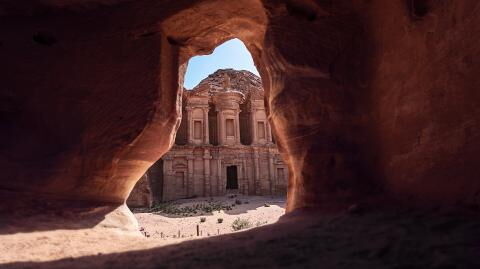In the heart of the mountains of southern Evia, off the Greek coast, stands a curious structure of some twenty ancient ruined buildings. Little is known today about the massive stone block structures, from the identity of its architects to the date of its emergence.
Discover our latest podcast
Commonly called ‘Drakospita’ ('dragon houses') by the local population, these constructions located at an altitude of about 1,400 meters, between the Ochi and Styra mountains, were first described in the 18th century by the British geologist and writer John Hawkins. And despite the interest shown by researchers in this site since then, many of its mysteries remain unresolved.
The mysteries of the ‘dragon houses’
In 2010, a comprehensive survey of the complex of buildings was published by the Swiss archaeologist Karl Reber. In total, there are 23 megalithic structures on the site, which are surprising in their architecture and durability. They were built with huge stone blocks as well as stone slabs stacked in a pyramidal pattern for the roofs, without mortar and without foundations.
As scholars note, these houses bear a striking resemblance to the Step Pyramid of Djoser - Egyptian Predynastic period - as well as the pre-Columbian temple complexes of Teotihuacan. In addition, each building has an opening on the roof that is probably there to let natural sunlight or moonlight illuminate the interior of the structures.
Another questionable point is the surprising location of these ‘dragon houses’, which are situated in key areas that allow long-distance observation of the surrounding area. In order to build the houses at this height, experts believe that their architects must have found a technique to move these massive stones from a much lower altitude.
Unsolvable Megalithic Mystery of ancient Greek “Dragon Houses”
— David Hanrahan (@uchroniaUtopia) July 5, 2022
The Dragon Houses of Euboea, which probably dates to the Preclassical period of ancient Greece, are one of the historical mysteries that have not yet been entirely solved.https://t.co/TAKgcKtu5Wpic.twitter.com/s3gjGFKTX4
Places dedicated to worship and astronomy?
The first to describe the site was the English geologist John Hawkins in the 18th century. Later, the German archaeologist H.N. Ulrichs compiled a detailed account of his observations on site in 1842. Further descriptions of several structures were provided by the Frenchman Jules Girard.
During excavations in the second half of the 20th century, a team of archaeologists led by Professor Nikolaos K. Moutsopoulos uncovered various artefacts suggesting that the structure may have been built around 1100 BC.
According to the researchers, the ‘Drakospita of Mount Ochi’, one of the main buildings at the site, served both as a place of worship and an observatory for astronomy. The inhabitants of the region, on the other hand, believe that the complex structures were farms, shelters and military camps. It should be noted that according to ancient local tradition, the word ‘dragon’ referred not only to the famous mythical beast but to any person with superhuman power.
This article was translated from Gentside FR.
Read more:
⋙ Ruins of a mysterious 3400-year-old empire discovered (PHOTOS)
⋙ Mysterious prehistoric stone circle discovered in the UK (Video)
⋙ Remarkably preserved 2000-year-old Roman temple discovered in Netherlands















